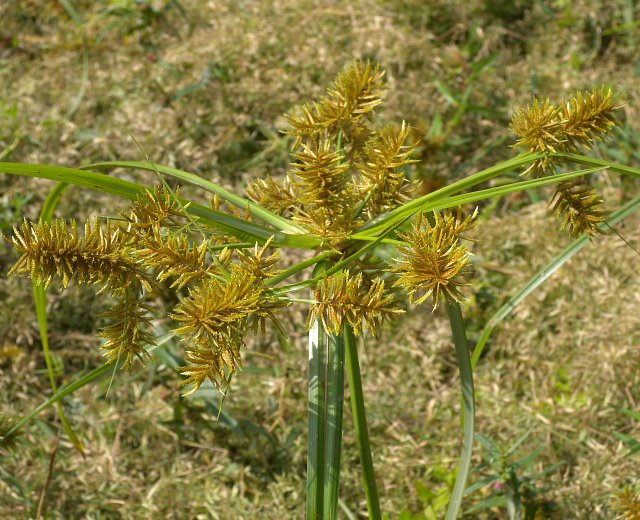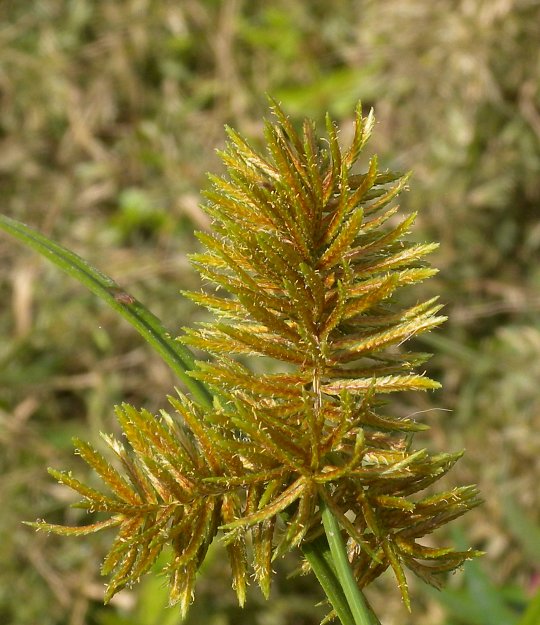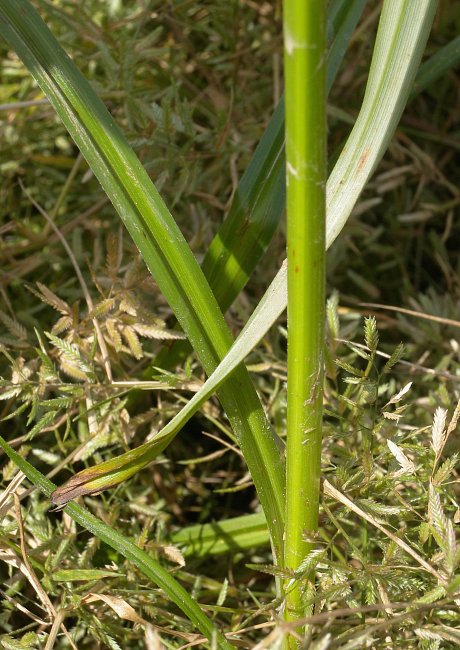Red-rooted Flatsedge
Cyperus erythrorhizos
Sedge family (Cyperaceae)
Cyperus erythrorhizos
Sedge family (Cyperaceae)
Description:
This sedge is a summer annual that is highly variable in height,
although it is typically about ½–1½' (15–45 cm.) tall at maturity. One
or more erect to ascending culms develop from the crown of the plant;
they are mostly light green, but often become purplish red near their
bases. The culms are also bluntly 3-angled, hairless, and smooth. About
2–3 alternate leaves occur near the base of each culm; their
blades are ascending, widely spreading, or arching. The leaf sheaths
are light green to purplish red and hairless.
The leaf blades are up to 1¾' (52.5 cm.) long and 8.5 mm. across; they
are centrally grooved and are shallowly M-shaped in cross-section. The
upper leaf surface is light green, hairless, and somewhat shiny, while
the lower leaf surface is whitish green, somewhat glaucous,
and dull-colored.

The culms terminate in a compound umbel of floral spikes that can span up to 6" (15 cm.) across and 4" (10 cm.) tall. A compound umbel typically has 3–8 straight peduncles (floral stalks) up to 3" (7.5 cm.) long that are strongly ascending to widely spreading; they are bluntly 3-angled to terete, light green, hairless, and rather stiff. At the tips of these peduncles, there are either solitary or a divergent cluster of 2–6 floral spikes. When clusters of floral spikes occur, they are nearly sessile to short-stalked. Floral spikes are ½–1½" (12.5–37.5 mm.) long, ½" (12.5 mm.) across or slightly more, and cylindrical in outline, resembling a bottle brush. Each floral spike has a flattened and slightly zigzag rachilla (central stalklet) along which there are 30–80 linear spikelets. The spikelets are more or less perpendicular to the rachilla. The color of the spikelets depends on the maturity of their scales; they are initially light yellowish green, but become yellowish to reddish brown with green central veins during the blooming period, later becoming a deeper shade of brown.

Each spikelet is about 5–8 mm. long and 1–1.5 mm. across, consisting of 12–22 partially overlapping floral scales. These scales are oblong-ovate in shape and keeled along their central veins; they have mucronulate tips (short-pointed) that cause the margins of the somewhat compressed (flattened) spikelets to appear slightly jagged. Individual scales are only 1–1.5 mm. long; each one has a perfect floret with a tripartite style and 3 anthers. The inflorescence of this sedge also produces several leafy bracts that are similar in appearance and size to the leaves at the base of the culm; these leafy bracts are ascending to widely spreading with the tips of the larger leafy bracts arching toward the ground. The blooming period occurs during late summer to early autumn, lasting 2–3 weeks for a colony of plants. The florets are cross-pollinated by the wind. Afterwards, the florets are replaced by small achenes. The pale-colored achenes are about 0.5–1 mm. long, ovoid, and 3-angled in shape; they are light yellow, light gray, or light reddish brown. The achenes are small enough to be blown about by the wind or carried by water to some extent. The root system has fibrous roots that are often reddish (otherwise white) and slightly fleshy. This sedge reproduces by reseeding itself.

Cultivation: The preference is full sun, moist conditions, and exposed sandy soil. Most growth and development occurs during the summer and early autumn. The seeds often germinate in ground that has been exposed to flooded conditions during the spring. The size of this flatsedge (Cyperus) can be highly variable; mature flowering specimens can be as small as 3" (7.5 cm.) in the field to as large as 3' (90 cm.) tall.
Range & Habitat: Red-rooted Flatsedge occurs occasionally throughout Illinois (see Distribution Map), where it is native. This sedge is widely distributed in the eastern one-half of the United States, and it also occurs in some areas of western United States. Habitats include sandbars and mudbars along rivers, sandy banks of rivers, exposed low shorelines along lakes and ponds, and ditches. Disturbed areas with exposed sandy ground are highly preferred.

Faunal Associations: Insects that feed on the foliage and other parts of this and other flatsedges (Cyperus spp.) include the larvae of such moths as Bactra verutana (Javelin Moth) and Spodoptera frugiperda (Fall Armyworm); larvae of Euphyes vestris (Dun Skipper); Sphenophorus aequalis (Clay-colored Billbug) and other billbugs; larvae of Plantella caudata (Sedge Gall Midge); Ischnodemus rufipes (a chinch bug); Sipha flava (Yellow Sugar Cane Aphid) and other aphids; Pseudococcus sorghiellus (Trochanter Mealybug) and other mealybugs; see Frick & Wilson (1978), Barlow & Kuhar (2009), Wagner (2005), Majka et al. (2007), Vaurie (1983), Felt (1917), Hoffman (1996), Blackman & Eastop (2013), and ScaleNet website (2014). Because this plant can be very abundant in sandy areas along major rivers and lakes, the seeds/spikelets of Red-rooted Flatsedge (Cyperus erythrorhizos) are considered an important source of food to many ducks, including the Northern Pintail, Green-winged Teal, Blue-winged Teal, American Wigeon, and Northern Shoveler (Havera, 1999; Anderson, 1959). Other wetland birds that feed on the seeds/spikelets of flatsedges include the Bobolink, American Tree Sparrow, Sora, Virginia Rail, and Wilson's Snipe (Martin et al., 1951/1961). The culms of flatsedges are a minor source of food for muskrats (Hamerstrom & Blake, 1939).

Photographic Location: The photographed plant was found in a sandy area along a river at Fox Ridge State Park in Coles County, Illinois.
Comments: Red-rooted Flatsedge (Cyperus erythrorhizos) can be distinguished from other similar sedges by its unusually short floral scales (1–1.5 mm.) that have prominent green veins on their keels, while their lateral sides become reddish brown during the blooming period. These scales appear even smaller in size because they are partially overlapping, causing the lateral sides of the linear floral spikelets to appear slightly jagged. This flatsedge also produces very small distinctive achenes that are between 0.5–1 mm. in length, 3-angled and ovoid in shape, and pale-colored. Other flatsedges (Cyperus spp.) in Illinois have longer floral scales and their achenes tend to be longer and more dark-colored. Unlike similar flatsedges in Illinois, the rachillas of the floral spikelets of Red-rooted Flatsedge persist for a longer period of time after the floral scales and achenes fall off. Another distinctive difference, as the common name suggests, is that the fibrous roots of this flatsedge are often red, rather than the more typical white. Overall, Red-rooted Flatsedge has a quite distinct and ornamental appearance, especially during the blooming period.

The culms terminate in a compound umbel of floral spikes that can span up to 6" (15 cm.) across and 4" (10 cm.) tall. A compound umbel typically has 3–8 straight peduncles (floral stalks) up to 3" (7.5 cm.) long that are strongly ascending to widely spreading; they are bluntly 3-angled to terete, light green, hairless, and rather stiff. At the tips of these peduncles, there are either solitary or a divergent cluster of 2–6 floral spikes. When clusters of floral spikes occur, they are nearly sessile to short-stalked. Floral spikes are ½–1½" (12.5–37.5 mm.) long, ½" (12.5 mm.) across or slightly more, and cylindrical in outline, resembling a bottle brush. Each floral spike has a flattened and slightly zigzag rachilla (central stalklet) along which there are 30–80 linear spikelets. The spikelets are more or less perpendicular to the rachilla. The color of the spikelets depends on the maturity of their scales; they are initially light yellowish green, but become yellowish to reddish brown with green central veins during the blooming period, later becoming a deeper shade of brown.

Each spikelet is about 5–8 mm. long and 1–1.5 mm. across, consisting of 12–22 partially overlapping floral scales. These scales are oblong-ovate in shape and keeled along their central veins; they have mucronulate tips (short-pointed) that cause the margins of the somewhat compressed (flattened) spikelets to appear slightly jagged. Individual scales are only 1–1.5 mm. long; each one has a perfect floret with a tripartite style and 3 anthers. The inflorescence of this sedge also produces several leafy bracts that are similar in appearance and size to the leaves at the base of the culm; these leafy bracts are ascending to widely spreading with the tips of the larger leafy bracts arching toward the ground. The blooming period occurs during late summer to early autumn, lasting 2–3 weeks for a colony of plants. The florets are cross-pollinated by the wind. Afterwards, the florets are replaced by small achenes. The pale-colored achenes are about 0.5–1 mm. long, ovoid, and 3-angled in shape; they are light yellow, light gray, or light reddish brown. The achenes are small enough to be blown about by the wind or carried by water to some extent. The root system has fibrous roots that are often reddish (otherwise white) and slightly fleshy. This sedge reproduces by reseeding itself.

Cultivation: The preference is full sun, moist conditions, and exposed sandy soil. Most growth and development occurs during the summer and early autumn. The seeds often germinate in ground that has been exposed to flooded conditions during the spring. The size of this flatsedge (Cyperus) can be highly variable; mature flowering specimens can be as small as 3" (7.5 cm.) in the field to as large as 3' (90 cm.) tall.
Range & Habitat: Red-rooted Flatsedge occurs occasionally throughout Illinois (see Distribution Map), where it is native. This sedge is widely distributed in the eastern one-half of the United States, and it also occurs in some areas of western United States. Habitats include sandbars and mudbars along rivers, sandy banks of rivers, exposed low shorelines along lakes and ponds, and ditches. Disturbed areas with exposed sandy ground are highly preferred.

Faunal Associations: Insects that feed on the foliage and other parts of this and other flatsedges (Cyperus spp.) include the larvae of such moths as Bactra verutana (Javelin Moth) and Spodoptera frugiperda (Fall Armyworm); larvae of Euphyes vestris (Dun Skipper); Sphenophorus aequalis (Clay-colored Billbug) and other billbugs; larvae of Plantella caudata (Sedge Gall Midge); Ischnodemus rufipes (a chinch bug); Sipha flava (Yellow Sugar Cane Aphid) and other aphids; Pseudococcus sorghiellus (Trochanter Mealybug) and other mealybugs; see Frick & Wilson (1978), Barlow & Kuhar (2009), Wagner (2005), Majka et al. (2007), Vaurie (1983), Felt (1917), Hoffman (1996), Blackman & Eastop (2013), and ScaleNet website (2014). Because this plant can be very abundant in sandy areas along major rivers and lakes, the seeds/spikelets of Red-rooted Flatsedge (Cyperus erythrorhizos) are considered an important source of food to many ducks, including the Northern Pintail, Green-winged Teal, Blue-winged Teal, American Wigeon, and Northern Shoveler (Havera, 1999; Anderson, 1959). Other wetland birds that feed on the seeds/spikelets of flatsedges include the Bobolink, American Tree Sparrow, Sora, Virginia Rail, and Wilson's Snipe (Martin et al., 1951/1961). The culms of flatsedges are a minor source of food for muskrats (Hamerstrom & Blake, 1939).

Photographic Location: The photographed plant was found in a sandy area along a river at Fox Ridge State Park in Coles County, Illinois.
Comments: Red-rooted Flatsedge (Cyperus erythrorhizos) can be distinguished from other similar sedges by its unusually short floral scales (1–1.5 mm.) that have prominent green veins on their keels, while their lateral sides become reddish brown during the blooming period. These scales appear even smaller in size because they are partially overlapping, causing the lateral sides of the linear floral spikelets to appear slightly jagged. This flatsedge also produces very small distinctive achenes that are between 0.5–1 mm. in length, 3-angled and ovoid in shape, and pale-colored. Other flatsedges (Cyperus spp.) in Illinois have longer floral scales and their achenes tend to be longer and more dark-colored. Unlike similar flatsedges in Illinois, the rachillas of the floral spikelets of Red-rooted Flatsedge persist for a longer period of time after the floral scales and achenes fall off. Another distinctive difference, as the common name suggests, is that the fibrous roots of this flatsedge are often red, rather than the more typical white. Overall, Red-rooted Flatsedge has a quite distinct and ornamental appearance, especially during the blooming period.